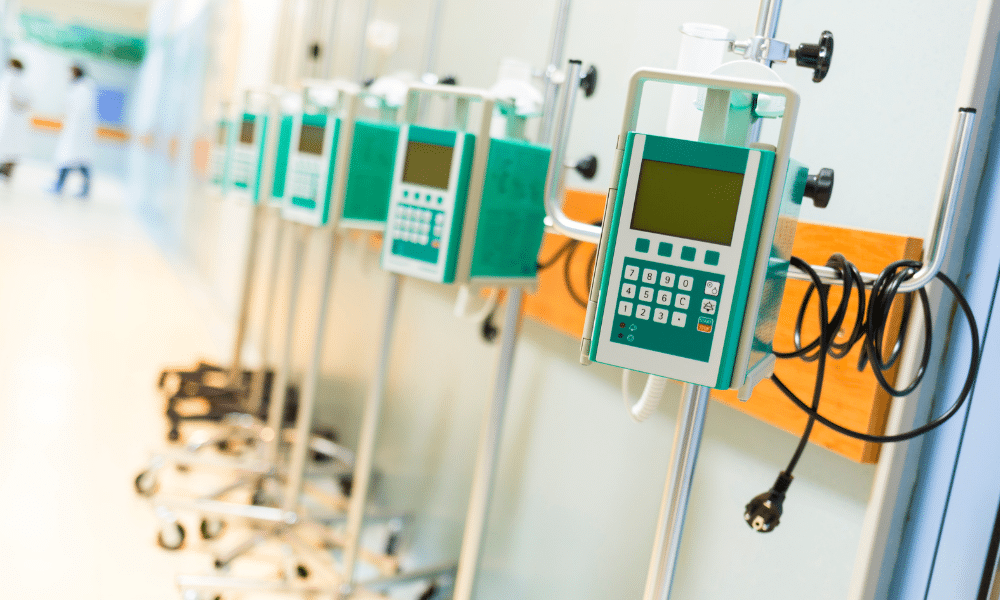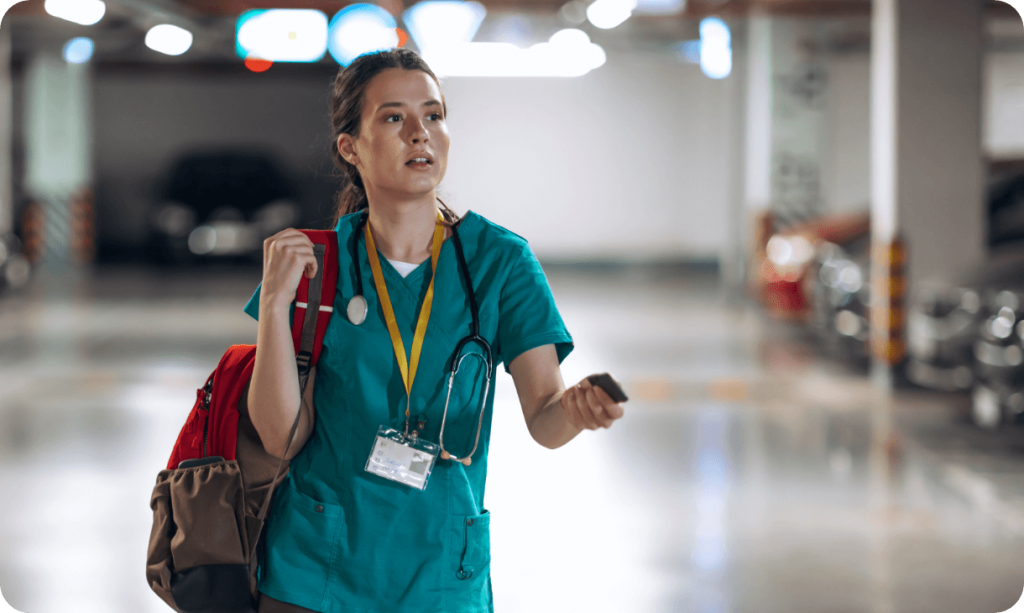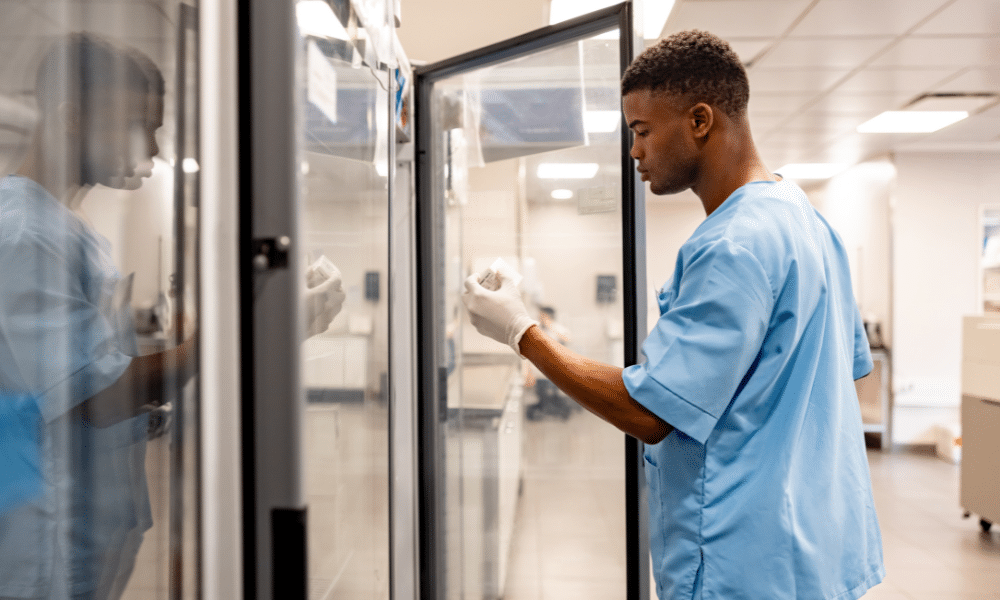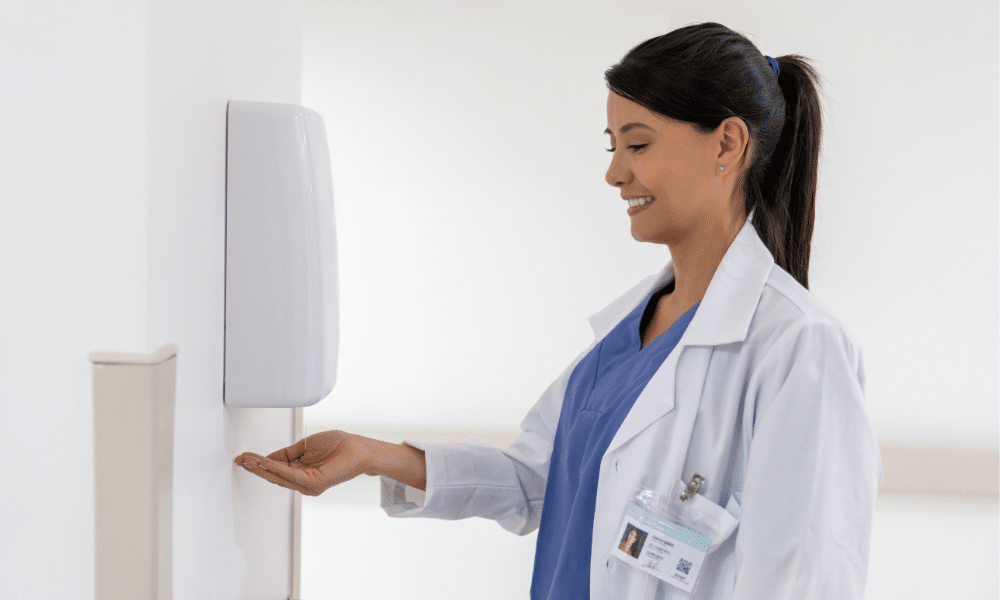Healthcare
Smarter hospital operations with real-time process intelligence
Manage critical assets, protect staff, ensure compliance, and streamline workflows – faster, more affordably, and without complex infrastructure
- Enterprise-wide location accuracy: AI-refined location with minimal hardware
- Unmatched software: powerful, intuitive, and built for adoption
- Unified platform: modular architecture for faster deployment, easier management, and lower total cost









Why do you need a RTLS solution?






Your success is our mission
Customer stories
We are dedicated to ensuring that our customers achieve their goals and realize the full value of real-time visibility. Discover how businesses like yours have achieved success with our AI-powered location intelligence.
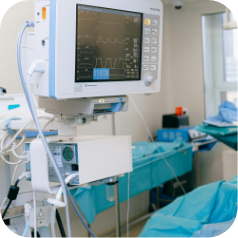
MediSys Health Network
JHMC Leverages Cognosos' LocationAI® to Achieve Fast ROI
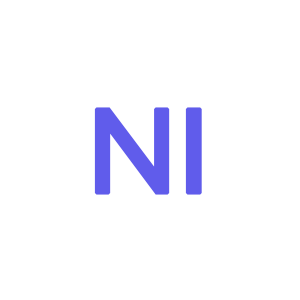
Nabil Ibrahim
JAMAICA HOSPITAL MEDICAL CENTER

Modern software and hardware stack purpose built for the outcomes you care about
Our hardware and software are built specifically for the complex environment of hospitals and the unique challenges of the healthcare business
Smarter install, less disruption
AI enables high performance with an ultralight infrastructructure, speeding installs, and dramatically reducing the hardware, implementation, and maintenance expense
Smarter accuracy, better decisisons
AI-refined location delivers true room-level precision—enabling faster response times, better workflow improvements, and more confident clinical and operational decisions.
Smarter modular architecture provides flexibility
Platform design enables faster deployments, easier management, and lower cost. Modern software stack includes built-in analytics and interoperability among other critical applications.
One platform. Multiple solutions.
CUSTOMER SUCCESS
Your partner for continued success
Partnering with Cognosos means we’re here for your success, actively monitoring and enhancing your experience to maximize value. You’ll gain access to an experienced team with extensive healthcare knowledge helping every step of the way.
- 24/7 network monitoring to maximize uptime
- Regularly scheduled security and performance updates to ensure a great user experience
- Expert RTLS and hospital ops team dedicated to your success and adoption
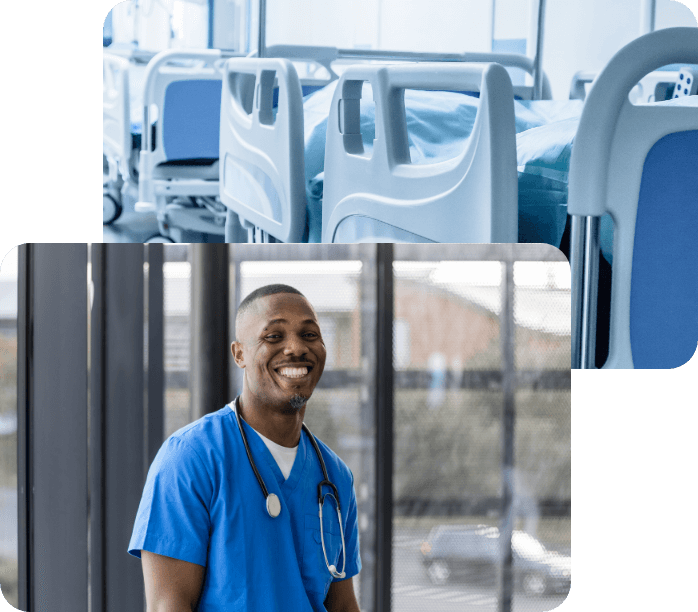
01. Preparing for your hospital's success
Stakeholder alignment & planning
IT prep
Meet with your onboarding manager
02. Onboarding & implementaion
Infrastructure installation
Site survey
User training & go-live
03. Maximizing time to value & complete adoption
Designated customer success manager
Quarterly business reviews (QBR)
On-going KPI tracking for ROI
RTLS Resources
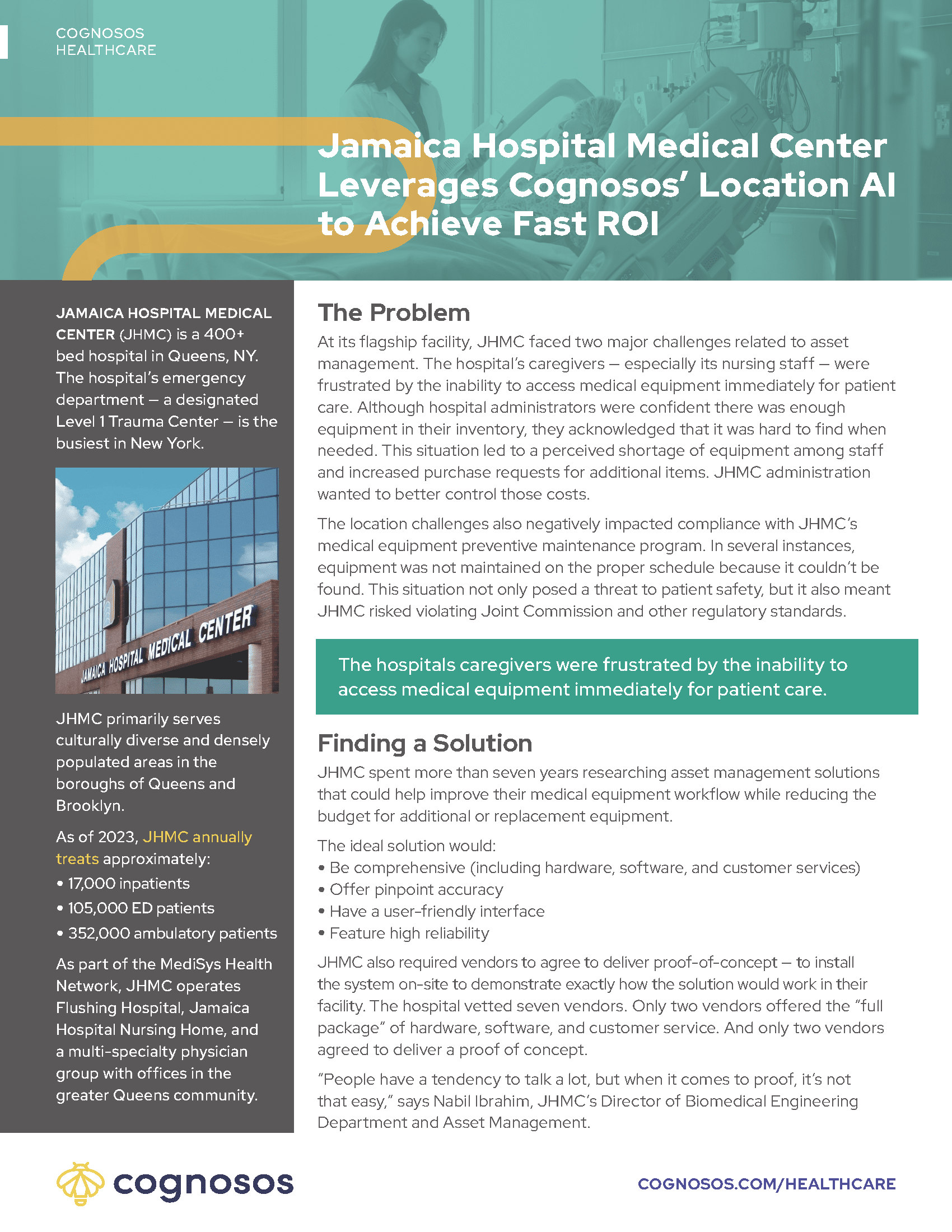
Case Study MediSys Health Network
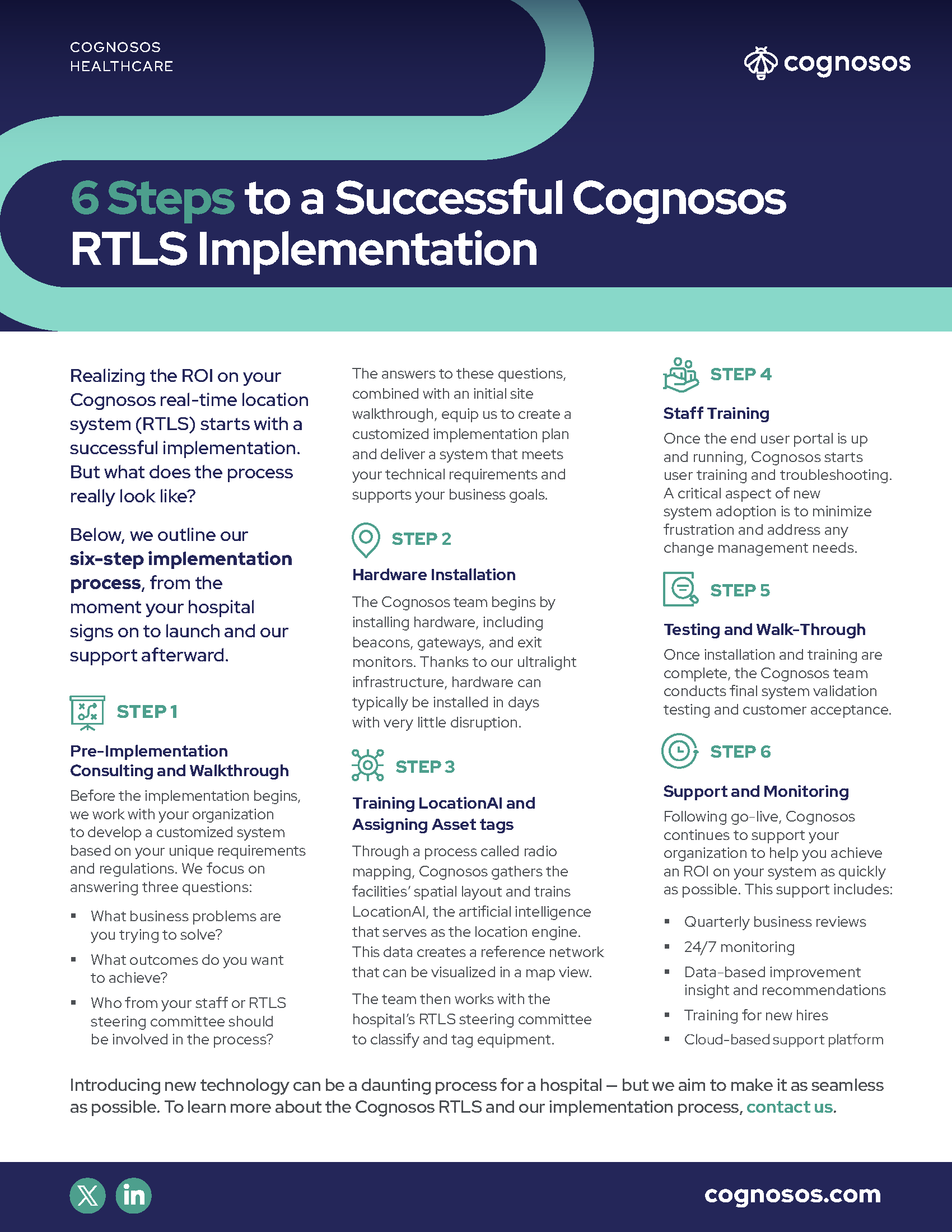
6 Steps to a successful Cognosos RTLS implementation
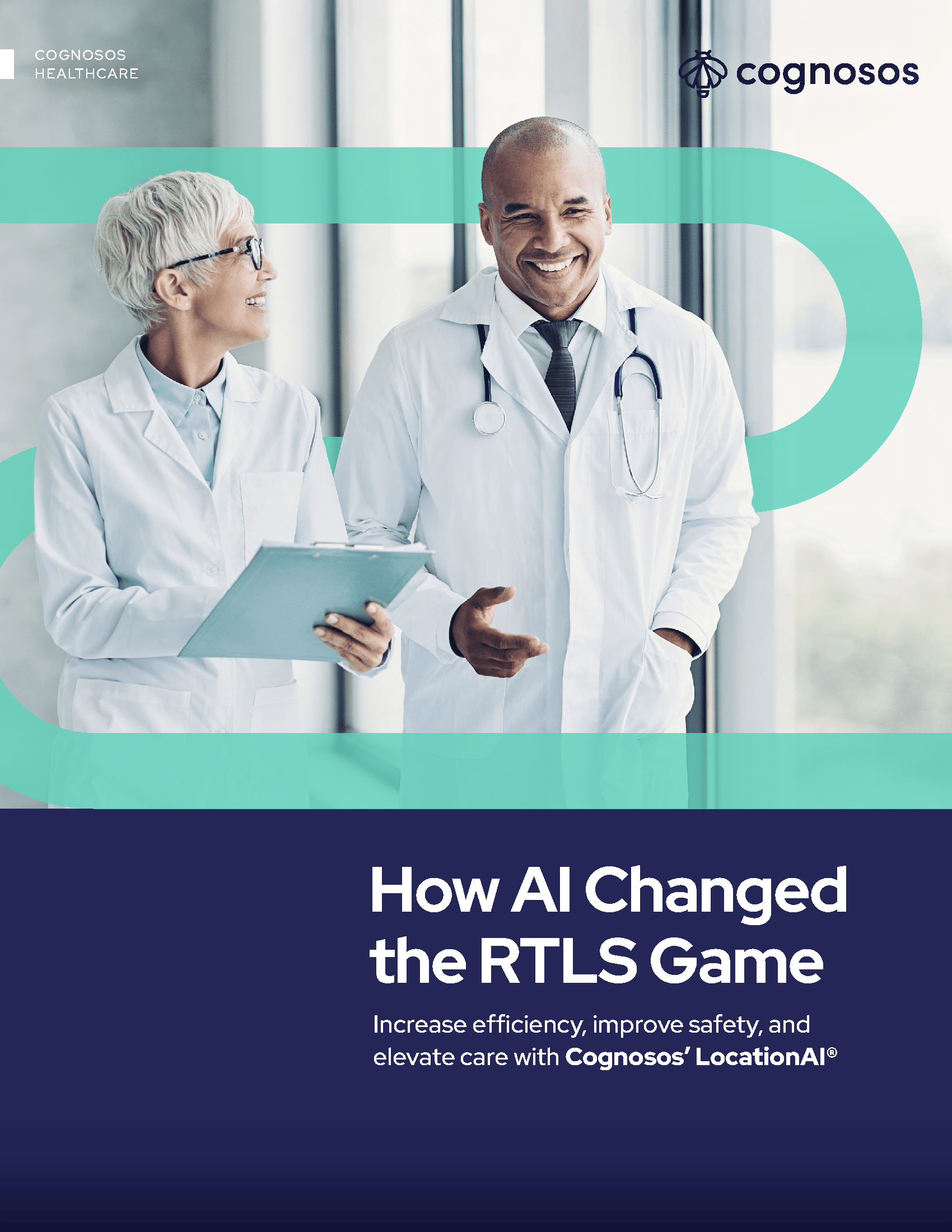
How AI changed the RTLS game white paper
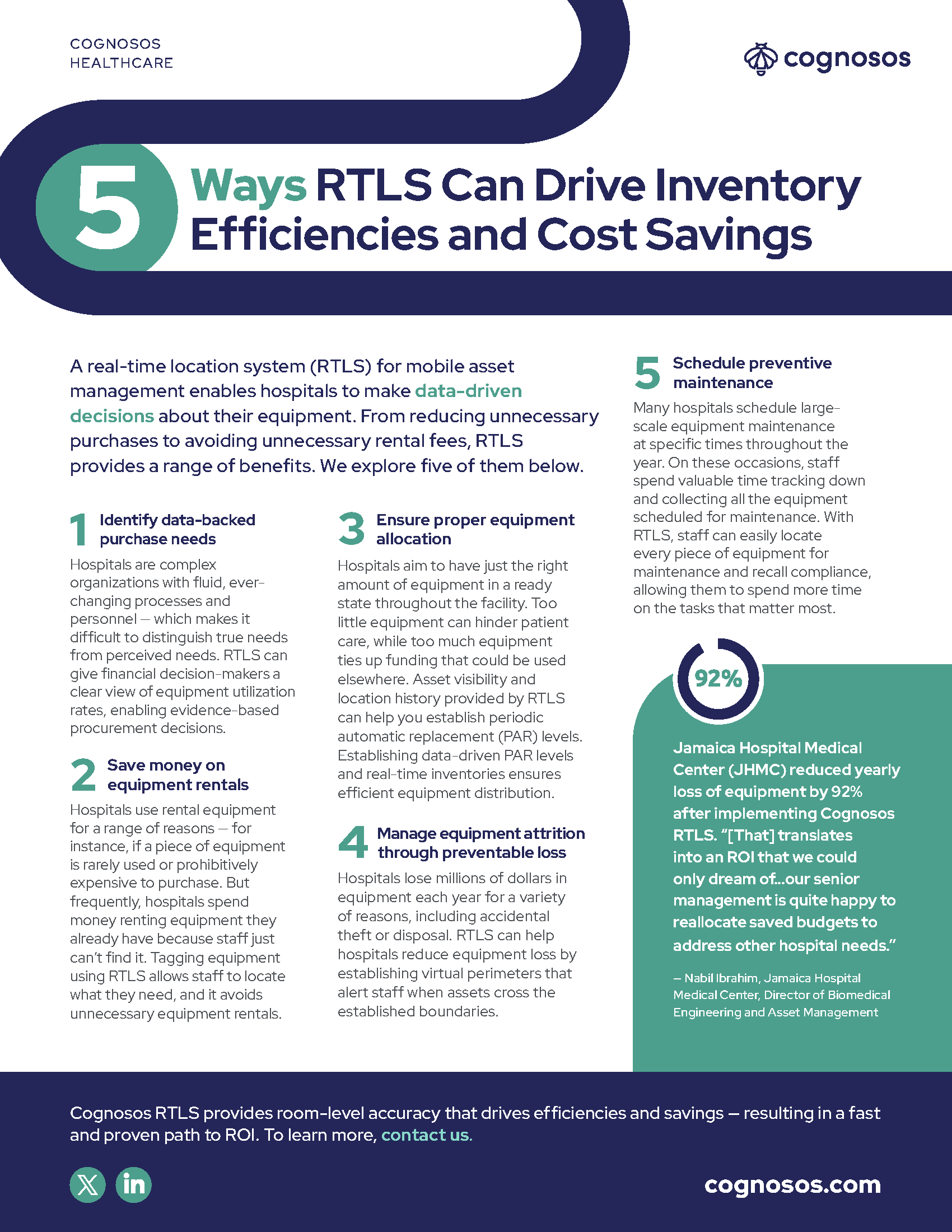
5 Ways RTLS can drive inventory efficiencies and cost savings
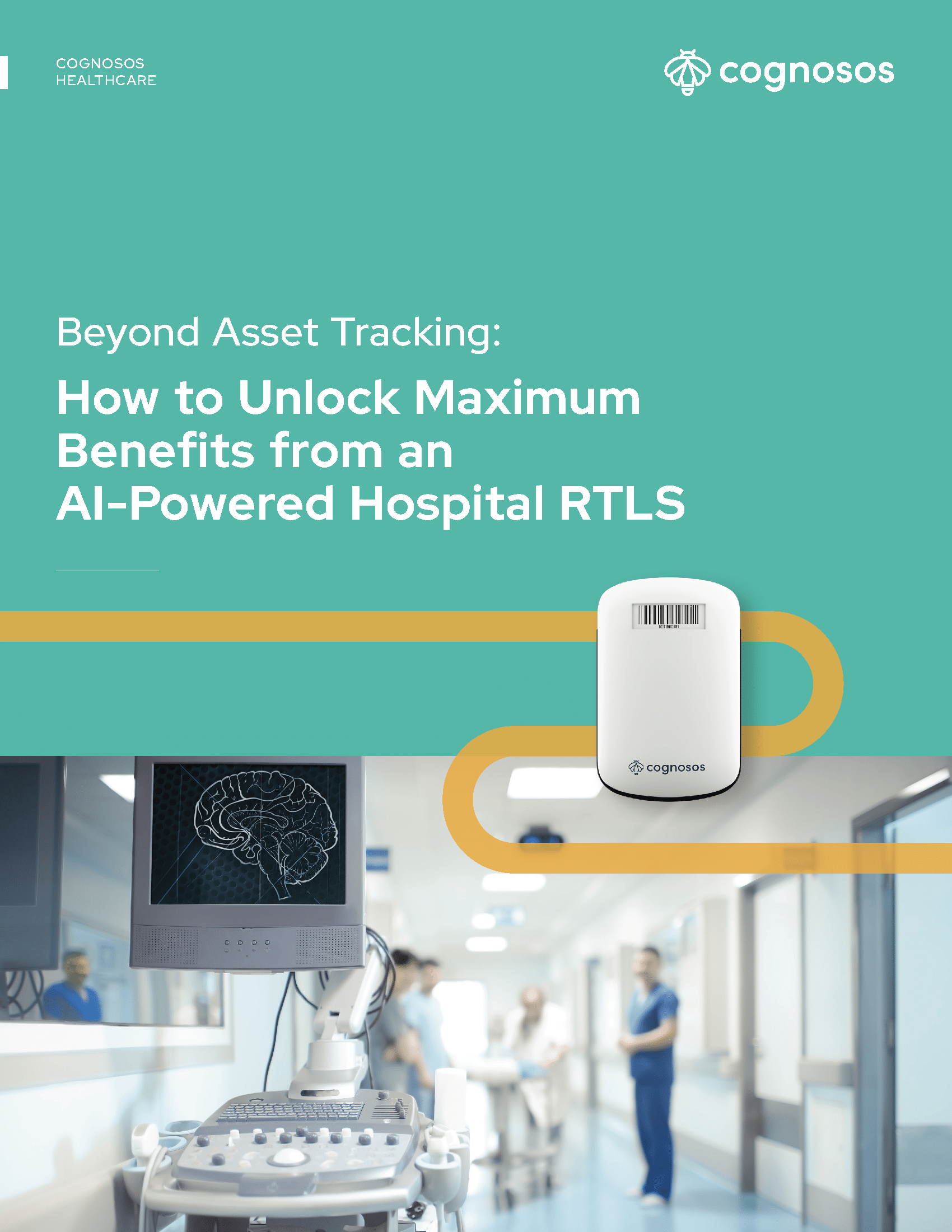
How to unlock maximum benefits from an AI-powered hospital RTLS

Transforming hospitals for future success in 2030 & beyond

Cognosos for Hospitals
Hospital RTLS
Cognosos utilizes the power of AI/ML to transform tracking data into operational intelligence, redefining the value of location solutions. Cognosos is able to quickly deploy with an ultra-lightweight footprint that excels in complex environments, producing a hard-dollar ROI within months through a subscription based service model.
Request a demo
Everything you need to know about
Healthcare real-time location systems (RTLS)
What is a RTLS?
Real-Time Location Systems (RTLS) in healthcare are used to provide immediate or real-time tracking and management of mobile medical equipment within hospitals and healthcare settings. These systems enable hospitals to optimize their operations, increase efficiency, and reap cost savings.
A common misconception about RTLS solutions is that they are designed to help hospitals “find stuff.” While any RTLS can technically do that, these systems provide the greatest value when they are used to help a hospital understand and improve their asset management processes, ensuring that the equipment nurses and other clinical staff need is always in the locations they expect that equipment to be. Achieving this precise level of visibility requires both reliability and accuracy.
What kind of different RTLS Technologies are available to hospitals?
Asset Management RTLS
Without understanding its mobile equipment utilization rate, it’s nearly impossible for hospitals to assess how large its fleet should be. The hospital is likely relying on anecdotal feedback to make its purchasing decisions. With asset management RTLS, hospitals gain a clear picture of their equipment workflow and can see precisely where equipment is at any moment and how long it’s been there. Once those variables are measured, hospitals can identify problematic areas, tweak workflows, and make improvements in its equipment utilization rate. For example: Say an RTLS shows a hospital’s infusion pumps typically sit idle for a long time in a soiled equipment closet before being collected for cleaning. The hospital can make changes to that cycle so that the infusion pumps are collected and cleaned daily, meaning they’ll go back into service faster, increase their utilization rate, and likely reduce the number of additional pumps the hospital is asked to purchase.
Staff Duress RTLS
An enterprise wide RTLS can help hospitals comply with Joint Commission, OSHA regulatory requirements as well as state by state legislation and guidelines, all of which are designed to mandate the development of workplace violence programs and initiatives for staff safety in hospitals. In general, RTLS solutions use a badge or similar device equipped with a button that staff can push discreetly in the event of an emergency. When the button is pushed, it sends a message to the RTLS, which can pinpoint the location of the staff member in distress, even if the person is moving around the hospital. The RTLS can also integrate with a hospital’s other technology systems, including public address and security systems, to facilitate a multi-tiered incident response.
Hand Hygiene RTLS
Hand hygiene is essential to reducing infection rates in hospitals, but it’s been historically difficult to monitor compliance among providers. An RTLS and intelligent hand soap or hand sanitizer dispensers can help. The RTLS can send an alert to health care providers when (a) they are near a hand soap or sanitizer dispenser, (b) have missed a hand hygiene opportunity, such as after moving from one patient room to another, or (c) have gone a prescribed period without washing their hands, according to a preset system. The RTLS can also record trends in hand hygiene activity over time so the hospital can enact safety policy changes and interventions when necessary.
Temperature Monitoring RTLS
Hospitals have many refrigerators, freezers, and other storage units that house temperature-sensitive items like medications, blood, tissue samples, and even food. The Joint Commission and other regulators maintain standards for the temperatures of these facilities but keeping track of those temperatures—and intervening as soon as there’s a problem—can be a challenge in a busy hospital. Temperature-sensitive RTLS tags can monitor storage units and send alerts to staff when a unit’s temperature rises beyond a pre-set range. This negates the need for time-consuming manual monitoring and ensures the hospital can react quickly to protect its temperature-sensitive assets.
Patient Monitoring RTLS
Patients typically receive a bracelet upon registration at a hospital. Those bracelets can include an embedded RTLS tag that can track the patient’s movements throughout the hospital so they can be located at any time. This can aid the hospital to provide better rounding management, plan for tests and ensure the staff throughout the hospital has better visibility to admitted patients who are in a patient room and discharge patients to enable more efficiencies of patient movement from the ER to [patient rooms. This is particularly important for the ER to avoid exceeding the allowed times for boarding in the ER. In an emergency, RTLS tags can help hospitals locate patients quickly to ensure no one is left behind when the building must be evacuated.
Infant Protection RTLS
RTLS solutions are commonly used to help hospitals track newborns via bracelets or tags affixed to them following their birth. These tags ensure the hospital can always locate newborns during their recovery or time in the NICU. In addition, sensors at all hospital exit doors can be programmed to sound an alert if an infant tag is detected nearby, preventing newborns from being taken from the hospital without authorization. Because infants’ tags are generally paired with their mothers’, an RTLS can help reduce the chance of accidental baby mix-ups.
Clinical Workflow Automation RTLS
An RTLS can provide real-time visibility into a hospital’s mobile equipment workflow, identifying bottlenecks that can cause delays between the patient room and the cleaning room, and back again. Based on that information, hospitals can automate alerts for storage rooms throughout the facility: When a quantity of a certain equipment class reaches a pre-set minimum level in a clean storage room, hospital staff are alerted to restock the room. On the other hand, when the quantity of a certain equipment class reaches a pre-set maximum level in a soiled storage room, hospital staff are alerted to move equipment to a central cleaning area. These alerts can save a hospital’s staff significant amounts of time compared with the typical “walk around the hospital and manually count equipment” method many organizations use.
Nurse Call Automation RTLS
Nurses are assessed on many tasks, but one of the most important is the speed with which they respond to patient calls. The timer starts when the patient pushes their call button and stops when the nurse pushes a cancellation button in the patient’s room, typically located near the head of the bed. But reaching that button can take time, as nurses must maneuver around equipment and other objects in a patient room. That not only increases nurses’ response time but also takes attention away from their first responsibility: patient care. If nurses have an RTLS-connected badge or device, the system can clear the patient’s call the moment a nurse walks into a room, and the nurse can immediately tend to the patient rather than a button. In addition, the RTLS can track nurse response times over time, and the data can be used to help improve safety procedures and policies.
What are the benefits of Hospital RTLS for asset management?
Reduce Equipment Loss
Hospital RTLS offers several benefits for preventing mobile medical equipment loss. They enable immediate alerts for equipment in trash or laundry, saving time and money by locating items before disposal. RTLS helps pinpoint the scene of accidental patient theft, facilitating swift recovery and minimizing inconvenience. Moreover, the system acts as a deterrent against employee theft by creating a Hawthorne effect, reducing the temptation to steal valuable equipment. Overall, RTLS enhances asset management, saves costs, and ensures the uninterrupted availability of critical medical equipment, ultimately improving patient care and safety in healthcare facilities.
Complete PM Cycles With Ease
The Joint Commission mandates that hospitals regularly assess and repair their equipment to ensure patient safety. This involves assessing a certain percentage of each asset class, and non-compliance can result in poor public relations and financial penalties. RTLS makes this PM process much more efficient by providing real-time tracking of equipment location, ensuring that the required percentage of assets in each class is assessed and maintained. This is particularly useful when responding to recalls or emergency updates, as equipment can be quickly located and addressed. Additionally, RTLS records any equipment losses, preventing hospitals from searching for items that have already left the building and ensuring accurate compliance reporting.
Automate Clean Equipment Distribution
Healthcare RTLS automates clean equipment distribution in hospitals by providing real-time visibility and tracking of mobile equipment between patient rooms and cleaning areas. This technology identifies workflow bottlenecks, allowing hospitals to optimize the collection, cleaning, and redeployment of equipment. For instance, an RTLS can alert staff when equipment enters soiled storage, ensuring timely cleaning and return to service. It can also notify staff when equipment levels in clean storage reach a predetermined minimum, ensuring availability. By streamlining workflows and improving equipment utilization, RTLS reduces the need for over-purchasing, saving costs and enhancing staff satisfaction, ultimately benefiting the hospital’s bottom line.
Make Data-backed Procurement Decisions
Instead of relying solely on anecdotal feedback from frontline staff, hospitals can use room-level RTLS to gain visibility into their equipment fleet’s operation. This data allows purchasing teams to make informed decisions based on actual equipment usage patterns. For example, they can identify surplus equipment during peak demand periods and avoid unnecessary purchases. RTLS empowers hospitals to optimize equipment procurement, ensuring they invest in equipment only when and where it’s truly needed, resulting in significant cost savings and more efficient asset management.
Increase Utilization of Existing Equipment
Without RTLS, it’s challenging to understand where equipment is and how it’s being used within the vast and complex hospital environment. RTLS allows hospitals to measure utilization rates accurately, indicating the percentage of equipment in use at any given time. This data helps hospitals identify equipment that may be sitting idle or underused, enabling them to make informed decisions to optimize equipment distribution and workflow. For example, if RTLS data show that certain equipment spends a significant amount of time waiting in a soiled storage closet, hospitals can adjust their processes to ensure quicker turnaround times, increasing equipment utilization and reducing the need for additional purchases.
Ensure equipment is available for clinical staff
Cognosos’ ProPAR™ plays a crucial role in ensuring that medical equipment is available for clinical staff when and where they need it in hospitals. Traditionally, hospitals rely on manual processes, with staff physically checking storage rooms to monitor and replenish equipment. This approach is labor-intensive, prone to errors, and inefficient, leading to equipment shortages and stressed staff.
ProPAR™ automates these processes by setting minimum and maximum PAR (Periodic Automated Replacement) levels for clean and soiled storage rooms across the hospital. When these levels are reached, the system automatically sends notifications to the appropriate staff, instructing them on the necessary actions to restock or empty storage areas. This automation optimizes equipment distribution, ensures that rooms are appropriately stocked, and prevents overstocking. It also eliminates the need for staff to engage in aimless wandering and enables them to be deployed more strategically and meaningfully throughout the hospital. As a result, clinical staff can access the required equipment promptly, reducing stress and improving overall hospital workflow efficiency.
What is the difference between RTLS and RFID?
RFID (Radio-Frequency Identification) and RTLS (Real-Time Location System) are related technologies with distinct purposes. RFID is primarily focused on identification and tracking through radio-frequency signals, providing static data when a tag is within the read range of a reader. In contrast, RTLS combines various technologies, including RFID, to deliver continuous, real-time location information with high accuracy. While RFID is suitable for applications like inventory management, RTLS excels in scenarios requiring dynamic tracking, such as real-time asset monitoring in manufacturing or precise patient tracking in healthcare.What is the History of RTLS in Hospitals?
Early Days (RTLS 1.0 – Early 2000s): RTLS technology emerged. These systems used simple tags but complex and expensive infrastructure, making installations labor-intensive and disruptive. Transition Period (RTLS 1.5 – Early 2010s): BLE technology became mainstream, but cost and accuracy issues persisted, limiting practicality of these solutions. The Next Generation (RTLS 2.0 – Late 2010s): Cognosos introduced an innovative solution with battery-operated tags and beacons, leveraging cloud technology and machine learning for precise, cost-effective, and efficient real-time tracking, marking a significant advancement in RTLS.
What is RTLS asset tracking?
What is RFID asset tracking?
An enterprise wide RTLS can be help hospitals comply with Joint Commission, OSHA regulatory requirements as well as state by state legislation and guidelines, all of which are designed to mandate the development of work place violence programs and initiatives for staff safety in hospitals. . In general, RTLS solutions use a badge or similar device equipped with a button that staff can push discreetly in the event of an emergency. When the button is pushed, it sends a message to the RTLS, which can pinpoint the location of the staff member in distress, even if the person is moving around the hospital. The RTLS can also integrate with a hospital’s other technology systems, including public address and security systems, to facilitate a multi-tiered incident response.
What Types of RTLS are Available on the Market?
RTLS involve three primary components:
- a tag affixed to an item
- a receiver to pick up a signal from that tag
- a system to process the data and determine the location of the item.
But how those three components work with one another – and how many of each component you need – varies widely between types of RTLS. Here is a snapshot of the main categories of RTLS available to hospitals today:
Infrared – Infrared was one of the earliest RTLS technologies. Its tags use light, and its receivers typically use signal strength to determine the location of the tags. The assumption is that if the receiver can see the infrared light from the tag, the tagged object is in the same room as the receiver. But infrared RTLS had some major problems: Something as simple as an open door could skew the RTLS’ calculation of a tag’s location.
Ultrasound – Like infrared, ultrasound is an RTLS technology and uses signal strength to determine the location of tags. The difference: ultrasound tags use high-frequency sound waves to transmit signals. Therefore, the assumption is that if the receiver can hear the sound waves from the ultrasound tag, the tagged object is in the same room as the receiver. Ultrasound RTLS suffered from the same challenges as infrared – the expense and disruption of the system’s infrastructure derails its ROI.
Wi-Fi – Wi-Fi RTLS came about when companies saw the massive infrastructure expense of infrared and ultrasound systems and decided to try building upon a hospital’s existing Wi-Fi access points. Both tags and receivers use the Wi-Fi network for communication and location. The approach worked in theory, but in practice required adding many additional access points to the hospital’s existing network and increasing that networks’ bandwidth. Even then, the Wi-Fi technology only offered zonal accuracy – with upward of 50-feet or more margin for error.
Bluetooth Low Energy (BLE) – BLE RTLS operates using a hospital’s Wi-Fi network and relies on radio frequencies and signal strength to determine tags’ locations. The big advantage of BLE is that the tags are extremely inexpensive. But, like Wi-Fi before it, BLE’s accuracy was terrible without adding a lot of infrastructure to reduce the system’s margin for error.
Ultra-Wideband (UWB) – Similar to Wi-Fi and Bluetooth, UWB tags use radio frequency to transmit signals, but its receivers use angle or time of arrival to determine the tags’ location. By relying on precise calculations based on the speed of sound or light, UWB RTLS can determine the location of a tag more accurately than any of the preceding technologies. But its range is very short and achieving its high level of accuracy requires major investments in infrastructure.
Non-Wi-Fi BLE Plus Machine Learning – This type of RTLS uses radio frequency to transmit signals – but the tags are the receivers, while the transmitters are beacons installed around the hospital. The technology uses low-cost, long-range networking capabilities to relay signals to the cloud. There, machine learning can determine the location of the tag. This enables the RTLS to provide room-level accuracy, but without a significant amount of infrastructure or cost. This is the technology that Cognosos uses for its RTLS solution.
How does Machine Learning Work in RTLS
Cognosos RTLS employs machine learning, particularly its LocationAI technology, to enhance location accuracy within a facility. It starts by collecting data from sensors and creating a reference network during setup, teaching the system to recognize signal patterns associated with different locations. Machine learning algorithms then continuously process incoming data, comparing real-time signals to learned patterns to determine the location of tagged items accurately. Notably, Cognosos RTLS is adaptable to changing environments, continually learning and improving its accuracy over time without extensive reprogramming.
RFID Radio Frequency Identification – RFID is a technology used to identify and track assets by using radio-frequency tags and readers. RFID tags store data that can be wirelessly read by RFID readers when the tags are within the reader’s radio-frequency field. To clarify, RFID helps determine when an asset is in proximity to a reader, but it doesn’t provide information about the asset’s exact location between two points. RFID is commonly applied for purposes like identification, inventory management, access control, and tracking of goods.
How does RTLS work?
The Cognosos RTLS involves four components:
- Beacons, installed infrequently in the ceiling throughout the hospital, ping out signals to a tag
- A tag receives a signal, then passes data to an internet-enabled gateway
- The gateway, installed in an existing hospital IT closet, sends data to the cloud
- LocationAI, Cognosos’ cloud-based platform, uses a machine learning algorithm to compare the information it receives with its reference network, pinpointing the tag with room-level accuracy.
How accurate is RTLS?
The accuracy of RTLS can vary, and it’s measured along two axes: margin of error and confidence. The margin of error indicates how close the system’s location measurements are to the actual position of the asset, and most companies often emphasize this aspect in their marketing. However, confidence is equally—if not more—important.
Confidence refers to how often the RTLS is accurate at the specified margin of error. In other words, confidence asks the question “how many times out of ten is your RTLS room-level accurate?”. If it’s nine times out of ten then that’s a high degree of confidence. Many RTLS systems are accurate only a small percentage of the time, which implies that high confidence can be lacking.
- How does the Cognosos RTLS ensure high confidence?
Cognosos ensures accuracy with high confidence through its proprietary cloud-based artificial intelligence system (LocationAI) that employs machine learning algorithms. This system delivers room-level accuracy, a significant improvement over coarser location granularity. The machine learning aspect continually refines the system’s performance, resulting in consistent and reliable location data. Moreover, Cognosos achieves this with unobtrusive and lightweight infrastructure, reducing the overall cost of ownership compared to legacy RTLS systems.
What Areas Can RTLS Solutions Cover?
Your RTLS should seamlessly extend its coverage to meet the unique demands of every area within your hospital. Cognosos RTLS excels in monitoring vital spaces like clean utility, soiled utility, surgery, pre-op, medication rooms, hallways, stairs, bays, garbage rooms, emergency, nurse stations, admissions, and post-ops, ensuring comprehensive real-time visibility of assets.
What is the difference between indoor & outdoor RTLS?
Cognosos provides distinct solutions for tracking assets, with outdoor solutions tailored for large outdoor areas, lots, and yards, while indoor asset intelligence is designed for improving asset tracking and management within complex indoor facilities like hospitals.
The technology, installation, and application of business rules differ between the two solutions to suit their respective environments.
Indoor RTLS overview:
Cognosos’ indoor asset tracking intelligence, utilizing low-cost Bluetooth beacons and the ability to leverage existing digital maps and Bluetooth infrastructure, is designed to seamlessly track equipment and inventory, enhancing inventory management, employee productivity, and operational efficiency while enabling users to apply customized business rules for inventory monitoring and asset security.
Outdoor RTLS overview:
Cognosos’ outdoor asset tracking solutions offer comprehensive visibility across large outdoor areas with minimal infrastructure requirements, featuring asset tags equipped with accelerometers for continuous location tracking, designed for optimizing outdoor asset management by reducing dwell time, streamlining supply chain operations, and enabling the application of user-defined business rules based on geofence assignments.
Which Type of RTLS is right for my hospital?
Selecting the right type of RTLS for your hospital depends on your specific needs and circumstances. To make an informed choice, start by identifying the precise business problems you intend to address with the RTLS. If your goal is to efficiently track mobile medical equipment, locate assets, and analyze usage, consider a system that can differentiate between various areas within the hospital. Carefully assess installation and start-up costs, keeping in mind that legacy technologies can be costly and may entail room closures during installation. Factor in the total cost of ownership, considering maintenance and battery replacement expenses. Additionally, evaluate the actionability of the data produced by the system, as an inaccurate or limited system may not support sound decision-making.
How much does it cost to implement a hospital RTLS?
The cost of implementing an RTLS can vary based on factors such as your healthcare facility’s needs, chosen RTLS solution, and deployment scale. An often overlooked factor is the “cost of entry,” which is the initial expense to set up your asset tracking system. Opting for a high-cost entry vendor may delay your ROI.
While some RTLS solutions offer precise room-level accuracy, they often require substantial upfront costs and complex infrastructure, resulting in a delayed positive ROI of 16 months or more. The overall cost includes external expenses for the system and hardware, as well as internal costs related to IT resources, infrastructure adjustments, and hospital downtime.
That’s why it’s crucial to consider solutions like Cognosos, which feature a streamlined setup, reducing the need for a large initial investment while maintaining high accuracy within individual rooms, hallways, stairwells, and bays. With Cognosos, a positive ROI can typically be achieved in just 9 months due to our lower upfront costs.
How long does it take to implement RTLS in an average hospital?
Cognosos offers an eight- to 10-week installation and training process for their RTLS system, divided into five phases:
- Phase one involves hardware installation, which does not require entry into patient-care areas.
- Phase two focuses on both AI training for spatial data collection and tagging of equipment.
- Phase three includes system optimization and training for key personnel.
- Phase four entails final testing and a system walk-through with the RTLS steering committee.
- Phase five is when the Cognosos RTLS system goes live after all preparations and training, ensuring a smooth and efficient implementation process.
How do I achieve an ROI with RTLS?
To attain a Return on Investment (ROI) with a RTLS for your hospital, focus on three pivotal areas: first, RTLS can prevent unnecessary equipment purchases by offering precise data on equipment utilization, saving the hospital considerable expenses. Second, it reduces equipment loss, stemming from misplacement or patients taking items, through monitoring and alerts. This minimizes loss and the need for costly replacements. Lastly, RTLS optimizes the management of rental equipment, enhancing visibility and ensuring efficient usage of owned assets, which in turn reduces the reliance on rentals.
The speed of achieving an ROI depends on installation efficiency and entry costs, with solutions like Cognosos offering a swift path to ROI, typically within 9 months, thanks to its lightweight and cost-effective design compared to more cumbersome alternatives.
Which Hospital assets should I track?
First and foremost, think about what you want to achieve with your RTLS:
- Do you want to improve how efficiently you use your assets?
- Are you deciding on the right size for your healthcare equipment fleet?
- Are you aiming to keep track of equipment to ensure it’s properly maintained?
Once you have a clear understanding of your goals, consider these five tips to help you decide what to tag — and what not to tag.
- Prioritize tagging your largest asset fleets, like infusion pumps, to achieve substantial ROI by avoiding unnecessary purchases.
- Tag scarce but essential equipment to optimize resource allocation and prevent over-purchasing.
- Identify and tag high-loss items, such as sequential compression devices, to reduce costs by recovering misplaced equipment.
- Use tagging for regulatory compliance, ensuring timely maintenance, and preventing non-compliance fines, including monitoring medication expiration and pharmacy crash cart replenishment.
- Employ tagging to make informed purchasing decisions, leveraging RTLS data to understand equipment utilization and achieve immediate cost savings. To maximize ROI, consider tagging as many asset classes as possible for comprehensive insights.
How To Create a Request for Proposal (RFP) for RTLS Services?
Creating an RFP for RTLS services in healthcare involves the following four key steps:
- Begin by clearly outlining the specific business problem you aim to address, ensuring it is measurable and specific.
- Identify the desired outcomes you seek to achieve with the RTLS solution, such as real-time equipment tracking and enhanced decision-making.
- Assess the vendor’s confidence in delivering these outcomes, especially in terms of system accuracy. A good way to do this is to ask for an RTLS pilot program at your hospital. This is a small installation of the RTLS solution in a specific part of your hospital, and it gives you the opportunity to take the technology for a “test drive”.
- Request a comprehensive estimate of the Total Cost of Ownership (TCO), including both upfront and ongoing costs.
A well-structured RFP will serve as a valuable tool to help you evaluate various RTLS solutions, make informed decisions, and understand the trade-offs between different offerings, ultimately aiding in the selection of the right RTLS solution for your healthcare facility.

